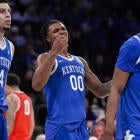Before the FBI consumed the off-season news cycle of college basketball, one of the big stories was that the NCAA selection committee has redefined the categories that define the quality of a win or loss. The categories are still based on the RPI, as they always have, but now there is a game location element as well.
Previously, games were divided into four tiers based on the RPI of a team's opponent. Those tiers were games against teams ranked 1-50, 51-100, 101-200 and 201 and higher. Those rankings will still apply for neutral site games, but have been altered for home and road games. The new tiers are as follows.
| | Home | Neutral | Road |
| | vs. RPI | vs. RPI | vs. RPI |
| Tier 1 | 1-30 | 1-50 | 1-75 |
| Tier 2 | 31-75 | 51-100 | 76-135 |
| Tier 3 | 76-160 | 101-200 | 136-240 |
| Tier 4 | 161+ | 201+ | 241+ |
They did this to acknowledge that it is more difficult to win on the road than at home. That is also the reason for the change to the RPI formula several years ago, which put more weight on road wins and less on home wins.
The conventional wisdom is that this will help non-major teams, who are often forced to play better teams away from home in order to get those games at all. They also simply cannot schedule as many home games as major conference teams because they cannot buy those games, or find themselves in the position of being bought.
Here is a look at how teams on the cut line of the last two NCAA tournaments, as well as some other teams of interest, would have been impacted if these tiers were in place.
2017
(No. 10 seed -- automatic qualifier)
Road games with a higher tier under new system (4): Wins at Colorado State (Tier 2 under old sytem to Tier 1 if new system had been in place), at Missouri State, at Bradley, at Indiana State (4 to 3).
Home games with a lower tier under new system (5): Loss to Oklahoma State, Wins vs Illinois State (1 to 2), Northern Iowa, Loyola, Evansville (3 to 4).
Analysis: Good thing the Shockers won the Missouri Valley bid. They were a borderline at-large team anyway, and the best thing about their profile was that all of their losses were to Tier 1 teams. This would not have been true now.
(No. 9 seed)
Road games with a higher tier under new system (1): Loss at Georgia (2 to 1)
Home games with a lower tier under new system (4): Wins vs South Carolina (1 to 2), Texas A&M (2 to 3), Tennessee State (3 to 4), Loss to Bucknell (2 to 3)
Analysis: The Commodores were the first 15-loss team to get an at-large bid to the NCAA tournament. The committee thought enough of them to make them a 9-seed. They would not thought of them as well in this system.
(No. 11 seed)
Road games with a higher tier under new system (4): Loss at Providence, Marquette (2 to 1), Win at Georgetown (3 to 2) and DePaul (4 to 3)
Home games with a lower tier under new system (5): Wins over Wake Forest, Seton Hall (1 to 2), Utah, Lehigh (2 to 3) and Northern Iowa (3 to 4)
Analysis: You might think it is mostly a wash because about the same number of games moved in each direction, but Xavier went from 4-9 vs Tier 1 to 2-11. That might drop them to the NIT.
(First Four)
Road games with a higher tier under new system (4): Wins at Colorado State, TCU (2 to 1), Loss at Texas Tech (3 to 2), Win at Saint Louis (4 to 3).
Home games with a lower tier under new system (4): Loss to Oklahoma State (1 to 2), Wins over Washington State, Oklahoma, George Washington (3 to 4).
Analysis: Slightly better with a couple of road wins moving up to the top tier, but a home loss moving down.
(First Four)
Road games with a higher tier under new system (3): Win at College of Charleston, Losses at Northwestern, Clemson (2 to 1)
Home games with a lower tier under new system (3): Wins over Miami (1 to 2), Coastal Carolina, LSU (3 to 4).
Analysis: Wake would likely be more comfortably in with a 5-9 record vs the top tier as opposed to 3-9.
(First Four)
Road games with a higher tier under new system (2): Losses at Boston College, DePaul (4 to 3)
Home games with a lower tier under new system (5): Wins over Rhode Island, Xavier, Seton Hall, Virginia Tech (1 to 2) UMass (3 to 4)
Analysis: The Friars would be in trouble. Their two worst losses do not look quite as bad, but they go from 6-8 vs the top tier to only 2-8. That's not a good number.
(First Four)
Road games with a higher tier under new system (3): Loss at Arizona State (3 to 2), Wins at San Diego, Washington (4 to 3)
Home games with a lower tier under new system (2): Wins over Stanford (2 to 3) and Washington State (3 to 4)
Analysis: This is pretty much a wash. There isn't a significant move here.
(NIT)
Road games with a higher tier under new system (6): Losses at TCU (2 to 1), Tulsa (3 to 2), Murray State, Wins at Missouri State, Bradley, Indiana State (4 to 3)
Home games with a lower tier under new system (7): Wins over Wichita State (1 to 2), New Mexico (2 to 3), Northern Iowa, Fort Wayne, UT Martin, Loyola, Evansville (3 to 4)
Analysis: This is worse. The Redbirds' only top tier win drops out, leaving them 0-3 vs that group. Half of their low end wins move up, but that wasn't what kept ISU out of the field.
(NIT)
Road games with a higher tier under new system (3): Losses at Illinois, Northwestern (2 to 1), Nebraska (3 to 2)
Home games with a lower tier under new system (3): Losses to Maryland, Seton Hall (1 to 2), Wins over Indiana (2 to 3), Rutgers (3 to 4)
Analysis: It actually is a wash at the top, with two top tier losses moving each way. Iowa's profile is not materially affected.
(NIT)
Road games with a higher tier under new system (1): Win at Arizona State (3 to 2)
Home games with a lower tier under new system (5): Wins over Utah, Colorado, Stanford (2 to 3), Washington State, UC Davis (3 to 4)
Analysis: A profile that was not very good to begin with got worse.
(NIT)
Road games with a higher tier under new system (4): Win at Clemson, Losses at Pitt (2 to 1), Georgia Tech (3 to 2) and Boston College (4 to 3)
Home games with a lower tier under new system (5): Wins over Wake Forest, Miami, Monmouth (1 to 2), Eastern Michigan, Boston U (3 to 4)
Analysis: One of the complaints against the Orange was that they didn't have a top win away from home. That is a little better, but the high number of top tier wins, which was the only thing going for them, is not as high. Syracuse drops from 6-8 vs the top tier to 4-9. This is still an NIT team.
2016
(NIT)
Road games with a higher tier under new system (8): Loss at USC (2 to 1), Wins at UCLA, Georgia Tech, Siena (3 to 2), Win at St. Peter's, Losses at Canisius, Army, Manhattan (4 to 3)
Home games with a lower tier under new system (2): Loss to Iona (2 to 3), Win over Wagner (3 to 4)
Analysis: Monmouth was left out primarily because of three bottom tier losses. That is no longer a problem. Having three road wins upgrade to the second tier helps too. The Hawks did everything the committee asks teams like this to do and got slapped for it. The new system would almost surely correct this oversight.
(NIT)
Road games with a higher tier under new system (3): Wins at Rhode Island, Oakland, Green Bay (3 to 2)
Home games with a lower tier under new system (4): Wins over Iona, Belmont (2 to 3), Milwaukee and Detroit (3 to 4)
Analysis: Nothing significant happening here to change Valpo's fate.
(NIT)
Road games with a higher tier under new system (6): Losses at Syracuse (2 to 1), Siena (3 to 2), Lasalle, Wins at Canisius, George Mason, Saint Louis (4 to 3)
Home games with a lower tier under new system (3): Wins over Ohio (2 to 3), Duquesne and UMass (3 to 4)
Analysis: The Bonnies needed more quality wins to impress the committee and gets another quality loss instead.
(NIT)
Road games with a higher tier under new system (5): Losses at Alabama, Georgia (2 to 1), Wins at Clemson, Arkansas (3 to 2), Loss at Missouri (4 to 3)
Home games with a lower tier under new system (2): Wins over LSU (2 to 3) and Western Carolina (3 to 4)
Analysis: South Carolina was left out because of a putrid non-conference schedule. The committee is not changing how that is measured.
(NIT)
Road games with a higher tier under new system (3): Wins at Pepperdine (3 to 2), Loyola Marymount, San Francisco (4 to 3)
Home games with a lower tier under new system (3): Loss to Gonzaga, Wins over St. Mary's (1 to 2), Belmont (2 to 3)
Analysis: BYU did not have enough quality wins to get in and two of the ones they had get downgraded here.
(NIT)
Road games with a higher tier under new system (3): Loss at Pepperdine (3 to 2), Wins at Loyola Marymount, San Francisco (4 to 3)
Home games with a lower tier under new system (4): Wins over Gonzaga (1 to 2), Stanford, BYU, Grand Canyon (2 to 3)
Analysis: The Gaels' profile suffers some serious damage with four of their six wins in the top two tiers being downgraded.
(First Four)
Road games with a higher tier under new system (3): Win at Florida, Losses at South Carolina (2 to 1), Loss at Arkansas (3 to 2)
Home games with a lower tier under new system (5): Loss to LSU (2 to 3), Wins over Austin Peay, Detroit, Wofford, Auburn (3 to 4)
Analysis: The Commodores record in the top tier gets a little better and the downgraded wins do not hurt very much. This is probably still a tournament team.
(First Four)
Road games with a higher tier under new system (6): Losses at Tulsa, Northern Iowa (2 to 1), Illinois State (3 to 2), Wins at Saint Louis, Missouri State, Loyola (4 to 3)
Home games with a lower tier under new system (2): Wins over Evansville (2 to 3), Indiana State (3 to 4)
Analysis: Wichita State goes from 1-2 against the top tier to 1-4, but that probably isn't enough to push the Shockers out of the field. They no longer have what would have been called a bad loss.
(First Four)
Road games with a higher tier under new system (2): Loss at Ohio State (2 to 1), Win at NC State (3 to 2)
Home games with a lower tier under new system (0)
Analysis: Hardly any movement at all for the Wolverines, which would not put their position in jeopardy. There probably won't be many teams with so little difference.
(First Four)
Road games with a higher tier under new system (5): Loss at Temple (2 to 1), Wins at Missouri State, Tulane, East Carolina, UCF (4 to 3)
Home games with a lower tier under new system (6): Loss to Little Rock, Wins over Wichita State, UConn, Cincinnati (1 to 2), Iona, Houston (2 to 3)
Analysis: This is the team that nobody -- and I am not exaggerating -- thought should make the tournament. Three of Tulsa's four top tier wins get downgraded and that would have ensured a rightful spot in the NIT.
(No. 10 seed)
Road games with a higher tier under new system (2): Loss at Pittsburgh (2 to 1), Georgetown (3 to 2)
Home games with a lower tier under new system (7): Loss to Wisconsin, Wins over Notre Dame (1 to 2), Virginia Tech, Florida State (2 to 3), Lehigh, Elon, Texas Southern (3 to 4).
Analysis: One of the worst RPI teams to ever make the tournament, the Orange got in on the strength of their quality wins, both home and away. That does not change much here.
(No. 10 seed)
Road games with a higher tier under new system (6): Loss at Tulsa (2 to 1), Wins at LaSalle, USF, UCF, Tulane, loss at East Carolina (4 to 3)
Home games with a lower tier under new system (3): Wins over Cincinnati, UConn (1 to 2) and a loss to Houston (2 to 3)
Analysis: Temple loses a couple of top tier wins, but they had others. Their worst loss gets upgraded, so that helps.
So, like everything else, your mileage may vary. Some of the non-majors were helped, but others were clearly damaged. Even some of the majors came out a little ahead. The most interesting thing to me was that downgrading some good wins while upgrading some losses can make a team's record against the top tier or top two tiers look worse, and that could be something that hurts them during selections or seeding. A team's collection of losses may not look as bad, but an ugly record against Tier 1 has been enough to leave some teams out in the past. It's nice to have bad losses upgraded though, and that surely would have helped Monmouth in 2016.
One thing that is not changing is the RPI. That is still the measuring stick for this season. Strength of schedule, which is part of the RPI, is not changing either. The committee is still exploring its options regarding the RPI and other metrics and may have a change in store for the 2018-19 season.

















